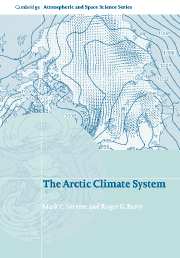Book contents
- Frontmatter
- Contents
- Preface page
- Acknowledgements
- List of Abbreviations
- 1 The evolution of knowledge about the Arctic and its climate
- 2 Physical characteristics and basic climatic features
- 3 The basic atmospheric heat budget
- 4 The atmospheric circulation
- 5 The surface energy budget
- 6 Precipitation, net precipitation and river discharge
- 7 Arctic ocean–sea ice–climate interactions
- 8 Climate regimes of the arctic
- 9 Modeling the arctic climate system
- 10 Arctic paleoclimates
- 11 Recent climate variability, trends and the future
- References
- List of selected websites
- Index
- Plate Section
5 - The surface energy budget
Published online by Cambridge University Press: 10 August 2009
- Frontmatter
- Contents
- Preface page
- Acknowledgements
- List of Abbreviations
- 1 The evolution of knowledge about the Arctic and its climate
- 2 Physical characteristics and basic climatic features
- 3 The basic atmospheric heat budget
- 4 The atmospheric circulation
- 5 The surface energy budget
- 6 Precipitation, net precipitation and river discharge
- 7 Arctic ocean–sea ice–climate interactions
- 8 Climate regimes of the arctic
- 9 Modeling the arctic climate system
- 10 Arctic paleoclimates
- 11 Recent climate variability, trends and the future
- References
- List of selected websites
- Index
- Plate Section
Summary
Overview
As reviewed in Chapter 3, the mean annual cycle of moist static energy storage in the Arctic atmosphere, considered as a whole, is determined from the interactions between the net radiation budget at the top of the atmosphere, net horizontal energy transports via the atmospheric circulation, and the net surface flux. These latter transfers were shown to be quite important. While Chapter 3 provides insights into the energetics of the Arctic climate system, a necessary next step is to examine the complete surface energy budget. The surface energy budget represents the transfers of energy across an infinitesimally thin surface interface (with no energy storages) that determine the net surface heat flux between the atmospheric column (or volume) and underlying ocean–ice–land column. Even today, direct surface measurements of the various budget terms, especially in a spatially distributed sense, are rather sparse. However, a reasonably comprehensive picture can be assembled by using available surface observations along with modern satellite-derived products and model results.
Shortwave radiation exchanges are strongly impacted by the high albedo of snow and ice covered surfaces. Both shortwave and longwave exchanges at the surface are greatly influenced by cloud cover, the former largely through cloud albedo and the latter through impacts on the effective atmospheric emissivity and temperature. During winter, the surface net radiation budget is almost always negative. Over land, this deficit is balanced by a small downward sensible heat flux from the atmosphere to the surface, and a small upward conductive flux through the snow cover.
- Type
- Chapter
- Information
- The Arctic Climate System , pp. 110 - 146Publisher: Cambridge University PressPrint publication year: 2005
- 2
- Cited by



